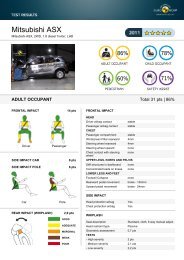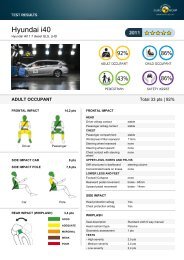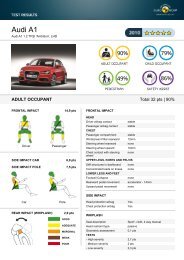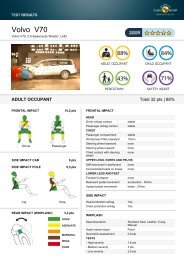Pedestrian Test Protocol - Euro NCAP
Pedestrian Test Protocol - Euro NCAP
Pedestrian Test Protocol - Euro NCAP
Create successful ePaper yourself
Turn your PDF publications into a flip-book with our unique Google optimized e-Paper software.
pedestrian testing will be required for all bonnet top test locations.<br />
2.3.2.2 For systems that do not fully deploy before the HIT of all statures, then dynamic<br />
pedestrian testing will be required for all bonnet top locations.<br />
2.3.2.3 The vehicle manufacturer must determine the wrap around distance for each test<br />
location and establish the relevant head impact time for that stature of pedestrian.<br />
2.3.2.4 Further details on performing dynamic tests are provided in Section 8.5.<br />
2.4 Protection at Speeds below the Deployment Threshold<br />
2.4.1 Exemption zones<br />
2.4.1.1 <strong>Euro</strong> <strong>NCAP</strong> maintains that bonnets which offer protection without a deployable<br />
device, offer protection at lower speeds and some protection at higher speeds.<br />
Therefore, <strong>Euro</strong> <strong>NCAP</strong> requires that vehicles equipped with deployable pedestrian<br />
protection systems also provide protection at impact speeds below the system<br />
deployment threshold on the part of the vehicle affected by the deployable pedestrian<br />
protection system.<br />
2.4.1.2 The area of the vehicle considered will be all grid points that have a distance measured<br />
in the lateral Y axis of 50mm or more inboard from the side reference lines and 50mm<br />
or less measured in the lateral Y axis outboard from the movable bonnet shut line. See<br />
Figure 1.<br />
2.4.1.3 The area will also extend rearward from the 1000mm WAD up to the rear of the<br />
movable bonnet top defined in 2.1.7. Child/small adult headforms will apply to grid<br />
points from 1000mm to 1700mm WAD inclusive and adult headforms will apply to<br />
grid points rearward from 1700mm up to the rear of the movable bonnet top. See<br />
Figure 1.<br />
2.4.1.4 Where parts of the movable bonnet are to be tested in the deployed position e.g. based<br />
on head contact time, and others are not, the area of consideration will include all grid<br />
points that are located between the rear of the movable bonnet top and 50mm forward<br />
or less from the most forward part of the bonnet that will be tested in the deployed<br />
position. See Figure 1.<br />
2.4.1.5 The vehicle manufacturer is required to provide the <strong>Euro</strong> <strong>NCAP</strong> Secretariat HIC15 or<br />
colour data showing that, at the lower deployment threshold speed, no grid point<br />
within the area mentioned above that is predicted green, yellow or orange at 40km/h<br />
shall produce HIC values above 1350 at the lower deployment threshold.<br />
2.4.1.6 For no less than 2/3rds of the total number of grid points within the prescribed area,<br />
HIC values must not exceed 1000.<br />
2.4.1.7 Data shall be provided for each grid point according to the following performance<br />
criteria:<br />
HIC15 < 1000 = Yellow<br />
1000 < HIC15 < 1350 = Orange<br />
2.4.1.8 Up to three physical tests may be performed to verify the CAE data at just below the<br />
deployment threshold speed. These tests will be selected at random by the <strong>Euro</strong> <strong>NCAP</strong><br />
Secretariat.<br />
2.4.1.9 Where any of the criteria in Section 2.4.1.5to 2.4.1.7 are not met then all pedestrian<br />
tests will be performed with the bonnet in the undeployed position.<br />
Version 7.0<br />
March 2013<br />
7
















